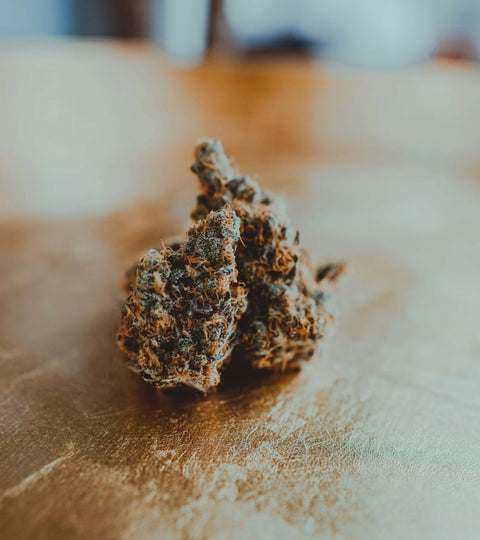The Art of Selecting the Perfect Cannabis Strain
Table of Contents
- Understanding Cannabis Strain Varieties
- The Importance of Cannabinoid Profiles
- Terpenes: Flavor and Aroma
- Cultivation and Quality
- Personal Preferences and Desired Effects
- Consulting the Experts
- FAQs
- Conclusion
Introduction
In our journey of discovering the ideal cannabis experience, understanding the distinction that seperate one strain from another is crucial. Here at Goldleaf we have joy in sharing tools for guiding aficionados through the intricate processes of selecting the perfect cannabis strain that works for you, and find one that resonates with personal preferences and transforms your routine sessions, into ritual.
Dont forget to check out our Cannabis Taster Journal to help facilitate your adventure through guided entry pages and graphics designed to help you document the flavors, effects, and potency of your cannabis experiences.

Understanding Cannabis Strain Varieties
When walking into a dispensary shopping for a cannabis strain, you will discover that the cannabis strains are seperated in three category groups: Indica, Hybrid, and Sativa. These three common groups is what how the industry associates and communicates with consumers, growers, bud tenders, and brands to anticipate the strains effects.
While the scientific community will determine cannabis strain effects by studying the cannabinoid profile, looking at what cannabionids and terpenes the strain carries. Before stepping into the process of choosing a cannabis strain, it's important to understand the fundamental categories that define the diverse landscape of cannabis. Here are the strain types and their typical effects.
-
Indica: This strain type is popular due to its deeply relaxing and sedating effects. Indica-dominant strains are often sought after for their ability to alleviate stress and promote restful sleep. With their calming properties, Indicas are also preferred by users who seek relief from anxiety or chronic pain. In addition, this strain type is great for individuals looking to unwind after a long day.
Well Known Indica Strains: Granddaddy Purple, Northern Lights, Bubba Kush, Purple Kush
-
Sativa: This strain type offers a contrasting experience to Indica-dominant strains. Sativa strains are often used for their uplifting and invigorating effects. They're ideal when it comes to enhancing creativity, boosting a user's mood, and stimulating social interaction.
Sativa blends are often favored by artists, performers, and those who seek energizing lifts without sedation. They're often chosen for daytime use, when productivity and sociability is the desired outcome.
Well Known Sativa Strains: Green Crack, Jack Herer, Lemon Haze, Super Silver Haze
-
Hybrids: Representing the versatile middle ground between Indica and Sativa, hybrids blend the best characteristics of both parent strains. Whether leaning towards an Indica-dominant or Sativa-dominant profile, hybrids offer a balanced spectrum of effects that are tailored to meet diverse user needs.
These blends cater to users who seek a customized experience, where they can enjoy the therapeutic benefits of Indica's relaxation alongside the creative stimulation of Sativa, or vice versa. Hybrid strains come in a wide array of combinations, each with its own unique flavor profiles and effects in potency. This makes hybrids a popular choice for users seeking versatility and flexibility in their cannabis experience.
Well Known Hybrid Strains: Sour Diesel, Gorilla Glue (GG4), Girl Scout Cookies (GSC), Blue Dream
In 2021 a study conducted by Amazon or Amazons Mechanical Turk (mTurk), yes Amazon. Gathered a sample group of cannabis users (n = 179) that were surveyed via Mechanical Turks (mTurk).
Participants were asked about their prior use of, subjective experiences with, and opinions on indica versus sativa cannabis and completed hypothetical purchasing tasks for both cannabis subtypes.
Here is what they found as the likelihood of Using Indica/Sativa Cannabis in Different Scenarios

Note. Participants reported likelihood to use indica (open bars) or sativa (closed bars) cannabis in hypothetical scenarios using a 5-point Likert scale (1 = not very likely; 5 = extremely likely, y-axis).
Participants were asked how likely (mean ± SEM) they were to use indica/sativa cannabis in five hypothetical scenarios (x-axis, bolded): “if you were going to have to drive in the next 30 min,” “if you were going to have to go to work in the next 30 min,” “if you were at a party,” “if you were going to be going to sleep in the next 30 min,” and “if you were drinking alcohol.”
By understanding these basic categories and the unique medicinal traits they offer, you can be better equipped to navigate the wide varieties of cannabis strains available at your local dispensary. Find the perfect strain thats fits your desired effects and needs. Happy Hunting!
Also Read: CBD and THC: Understanding their Differences and Therapeutic Properties
The Importance of Cannabinoid Profiles
Each strain’s unique effects are largely determined by its cannabinoid profile. The two most prominent cannabinoids found in cannabis products are Tetrahydrocannabinol (THC) and Cannabidiol (CBD), although several other cannabinoids play a role in the overall effects each strain produces.
Lets examine the complexity of what certain cannabinoids can provide and the valuable insights into the diverse effects offered by different cannabis strains:
-
Tetrahydrocannabinol (THC): As the primary psychoactive compound in cannabis, THC is responsible for the euphoric "high" commonly associated with marijuana use. Cannabis strains with higher levels of THC tend to bring about more pronounced psychoactive effects, such as euphoria, relaxation, altered perception of time, and heightened sensory perceptions.

These strains are often the common choice for recreational users due to the euphoric and uplifting experiences they promote. Medical patients appreciate THC as well when it comes to managing pain, nausea, and appetite loss.
-
Cannabidiol (CBD): Unlike THC, CBD is non-psychoactive, meaning it does not produce a "high" or any intoxicating effects. Instead, CBD is known for its potential therapeutic properties, including anti-inflammatory, analgesic, and neuroprotective effects. Strains with higher levels of CBD are typically chosen for their medicinal benefits, offering relief from conditions such as chronic pain, inflammation, anxiety, depression, epilepsy, and insomnia.

Additionally, CBD can regulate some of the adverse effects of THC, such as anxiety and paranoia, making high-CBD strains suitable for users seeking the therapeutic benefits of cannabis without the intense psychoactivity that .
-
Other Cannabinoids: In addition to THC and CBD, cannabis contains a myriad of other cannabinoids that contribute to its overall effects and therapeutic potential. Cannabinoids like cannabigerol (CBG), cannabinol (CBN),tetrahydrocannabinolic acid (THCa), and tetrahydrocannabivarin (THCV) each have unique properties and interactions with the body's endocannabinoid system. Each one can influence things like mood, appetite, pain perception, and sleep.

By considering the cannabinoid profile of each product, consumers can make informed choices when selecting cannabis strains that align with their desired effects and therapeutic goals. Whether you're seeking relaxation, euphoria, pain relief, or a combination of benefits, understanding cannabinoid content allows for a more tailored and personalized cannabis experience.
Terpenes: Flavor and Aroma
Terpenes play a valuable role in defining the sensory profile and produced effects of each cannabis strain. These aromatic compounds help to shape the smell and flavor of the genetic strain, which can range from citrusy and sweet to earthy and pungent. Terpene profiles not only affect the overall experience but can also influence the therapeutic effects of the strain. For example, the terpene known as myrcene can help induce sedation, while limonene can uplift a user’s mood.
Here are some of the most common terpenes found in cannabis products:
- Myrcene: This is one of the most abundant terpenes found in cannabis, and it's known for the earthy and musky aroma it produces. Strains that are high in myrcene are often sought after for their intense relaxing and sedative effects. Myrcene is also believed to have anti-inflammatory properties and may contribute to the "couch-lock" sensation often associated with Indica-dominant strains.
- Limonene: Known for its bright, citrusy scent, limonene is a terpene that helps to enhance mood and relieve stress in users. Strains that are rich in limonene are preferred for their energizing effects. These blends are often used to combat anxiety, depression, and fatigue. Limonene is also believed to have antibacterial and antifungal properties.
- Pinene: This terpene produces a scent that's similar to fresh pine needles, and it's known for its ability to increase alertness, focus, and memory retention. It's an ideal terpene for users who are looking for a clearer and more functional high. Pinene is also thought to have bronchodilator and anti-inflammatory properties.
Cultivation and Quality
The cultivation process of a cannabis strain is important when it comes to the plant's overall quality and potency. Cultivation shapes practically every aspect of the final product, from its aroma and flavor profiles to the therapeutic effects it produces. In addition to the genetic makeup of each plant, environmental factors play an essential role in determining the development and eventual characteristics of a cannabis product.
Factors like soil composition, nutrient levels, water quality, and light exposure all contribute to cannabis growth and the way its chemical components come together. Additionally, cultivation techniques like pruning, training, and pest control can enhance or reduce the overall quality of a cannabis product.
Harvesting at the right time, when the cannabinoids and terpenes are at their peak levels, is also essential when it comes to maximizing a strain's potency and flavor. Further, the curing process, when harvested buds are dried and cured to perfection, is equally critical. Proper curing allows for the gradual removal of moisture while preserving the delicate terpene and cannabinoid profiles.
Also Read: Why is Cannabis Journaling a Great Wellness Practice
Personal Preferences and Desired Effects
Ultimately, choosing the perfect cannabis strain is a highly personal journey. For each cannabis user, it’s essential to consider the effects desired from the session, whether it’s to energize, relax, relieve body pain, or enhance creativity.

Checkout our Cannabis Taster and Cannabis Quality Reference Cards
Careful experimentation with different strains and monitoring the experiences yielded can help you hone in on the strain that best suits your needs at any given time. Take your time when it comes to your cannabis experimentation and be mindful of the sensations and effects that each strain you try presents.
Consulting the Experts
Whether you’re new to cannabis or you’re an experienced user, consulting with experts can always present you with useful information. Consider asking questions at your local dispensary or making use of helpful resources like Goldleaf’s Cannabis Journals. This way, you can gather and record incredible insights that will enhance your cannabis journey.
Cannabis journals are specifically designed to help you track and refine your cannabis preferences, as you can document the subtle nuances that make each strain unique. Online resources like Leafly.com and other dedicated education channels can also be amazing sources in your journey.
Frequently Asked Questions (FAQ)
Q: What factors should I consider when choosing a cannabis strain?
A: Consider factors such as your desired effects (relaxation, energy, creativity), THC and CBD content, terpene profile, method of consumption, and any medical conditions you're looking to address.
Q: How can I determine the THC and CBD content of a strain?
A: Look for lab-tested strains where the THC and CBD percentages are listed on the packaging or available online. Dispensaries provide this information on product packaging to help customers make informed choices. When in doubt, ask a staff member for information.
Q: How can I experiment with different strains to find what works best for me?
A: Start with small doses and keep a journal to record how each strain affects you. Pay attention to the effects on your mood, energy levels, and any alleviation of symptoms. It may take some trial and error to find the perfect fit.
Q: Are there any strains recommended for beginners?
A: Strains with balanced THC and CBD ratios or lower THC and higher CBD content are often recommended for beginners to minimize the risk of overwhelming psychoactive effects. Examples include Harlequin, Cannatonic, or Blue Dream.
Q: Should I consider the method of consumption when choosing a strain?
A: Yes, the method of consumption can impact how a strain affects you. For example, edibles tend to have a stronger and longer-lasting effect compared to smoking or vaping. Some strains may be better suited for specific consumption methods.
My Takeaway
Selecting the ideal cannabis strain that works for your biology can take some time. This requires patience, a good amount of note taking, some pictures to remember what the product looked like, and a balance of knowledge, sensory exploration, and personal reflection.
Giving yourself the space to listen and feel how your body is responding, is key to finding that lucky strain. By understanding the roles of cannabinoid content, terpene profiles, cultivation methods, and the effects you want to experience, you can become a knowledgable connoisseur of cannabis.
Dont forget to checkout all of our journals and find the journal that works for you. Grow, Love, Heal, and Elevate with Goldleaf
Image Credits







